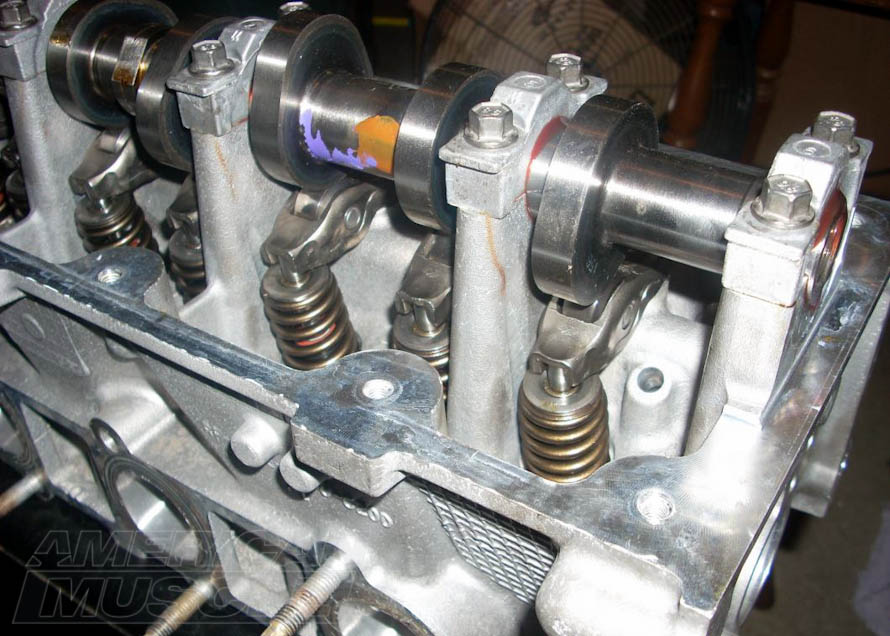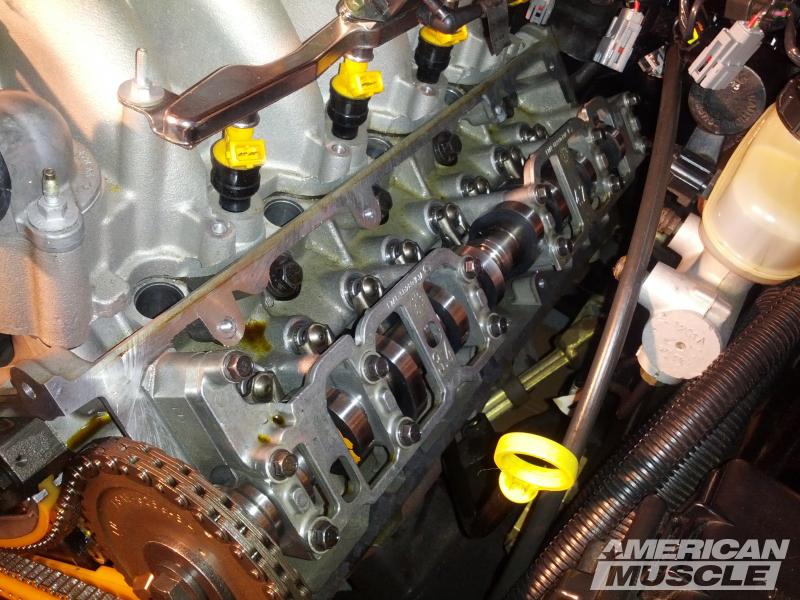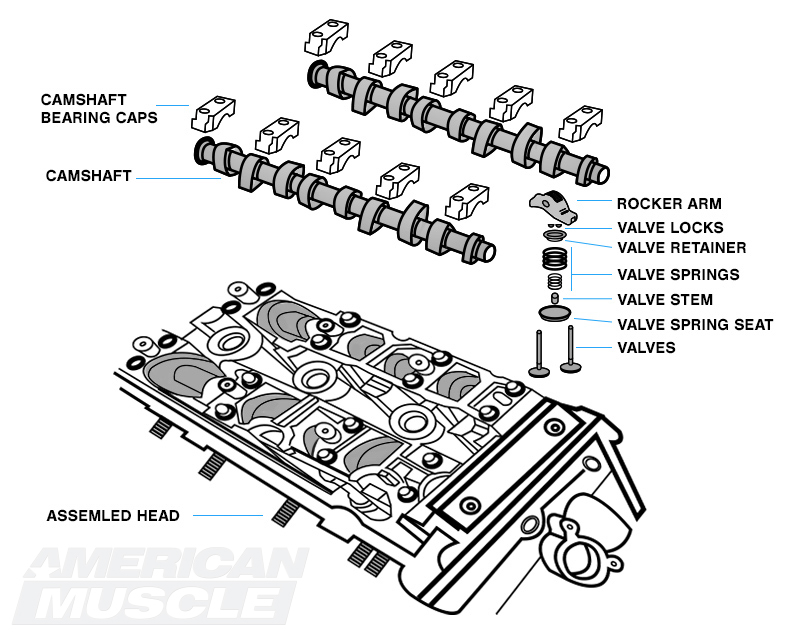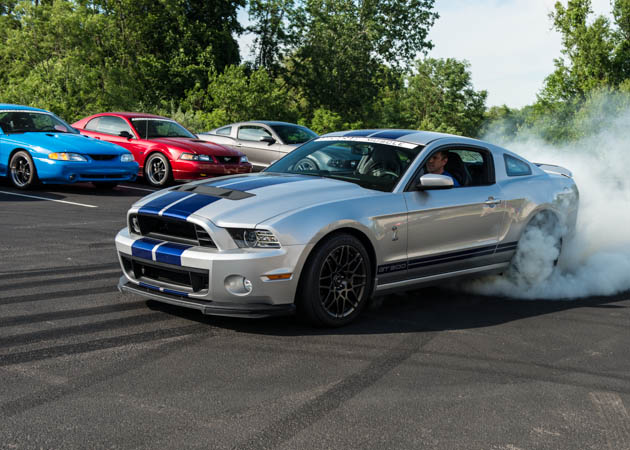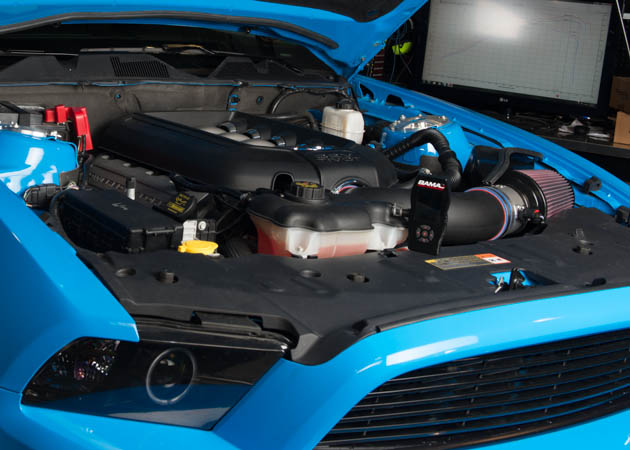One of the most crucial parts of an engine is the camshaft. This guide will serve to inform you on how camshafts function in different engine layouts.
Shop Mustang Camshaft
Whether you're looking for performance, sound, or both, new camshafts will have you grinning from ear to ear. Huge performance gains and a totally new sound are the two main reasons to purchase new cams for your Mustang.
Shop Camshafts
What Are Mustang Camshafts?
A camshaft is a component that controls the opening and closing of the intake and exhaust valves. By making adjustments to the timing, length of time valves are open, and how far the valves open, you control the power band of a motor. There are three common types of camshaft configurations seen today, and the Mustang has seen all three of them used in its engines in the last couple of decades.
- Overhead Valve (OHV)—the camshaft is placed in the engine block, and pushrods (hence "pushrod" motors) transfer the motion of the rocker arms to open and close the valves in the head
- Single Overhead Cam (SOHC)—the camshaft is placed at the top of the engine head and has less parts involved
- Dual Overhead Cam (DOHC)—the camshaft is essentially the same as SOHC, but contains two camshafts in each head
Overhead Valve Cams
The overhead valve (OHV) configuration is becoming less common. In this configuration, the camshaft is placed in the engine block, and pushrods transfer the motion of the camshaft to rocker arms that open and close the valves. Since the camshaft is below the valves what with the valves higher up and above the pistons, we get the term "overhead valve".
As the camshaft rotates, lifters ride on the camshaft lobes which raise the pushrods. As the pushrods rise, they push one end of the rocker arm which in turn pushes the valve down and opens it.
Due to the number of components used in this type of camshaft approach, failure of the valvetrain has a higher chance than with other options. While the quality of the components used will play a factor in this, the fact remains using fewer components has a distinct advantage.
In addition the overhead valve configuration is the least efficient of the three types due to the friction and mass of all the components. The last overhead valve V8 Mustang was a 5.0, used up to 1995.
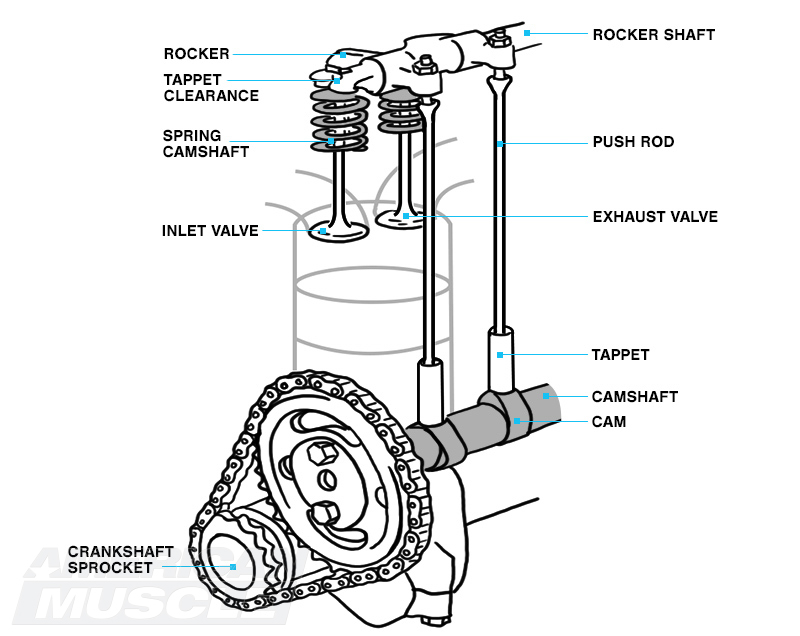
Single Overhead Camshafts
SOHC stands for single overhead camshaft. It differs from the previous camshaft configuration by placing the camshaft at the top of the engine head. The camshaft is directly under the valve cover, and above the valves, giving it the overhead camshaft designation. The “single” designation comes from how one camshaft is mounted in each engine head.
The overhead configuration has a couple of distinct advantages. The first of these is the reduction of parts necessary for the camshaft to open and close the valves. The need for pushrods and lifters is eliminated, as the camshaft opens the valves by operating the rockers directly as it spins.
This reduction of parts increases reliability and makes the engine’s valvetrain much more efficient. The 4.6 Liter V8 found in the Mustang GT uses a single overhead camshaft, in both the two valve versions found from 1996 to 2004 as well as the three valve versions found in the 2005-2010 Mustangs.
NewArrivals
Dual Overhead Camshafts
The dual overhead camshaft (DOHC) is essentially the same configuration as the single overhead camshaft, the difference being there are two camshafts in each head as opposed to one. For engines that use four valves per cylinder, dual overhead camshafts are the preferred method of valvetrain operation because of the higher number of valves. An example of this configuration is the 32 valve engines used in the 1996-2004 Mustang Cobra and Mustang Shelby GT500. The 2011-2018 5.0L Coyote powered Mustangs are also DOHC.
Mustang Camshaft Timing
Camshaft timing refers to how the camshaft operates in relation to the crankshaft. This is referred to in degrees advanced or retarded. This essentially means the valves open before or after top dead center.
Performance characteristics can be altered, however, by advancing or retarding the camshafts position relative to the crankshaft. This can be a complex procedure, and an incorrect setting can cause the engine’s pistons to strike the valves.
How Much Lift Can I Get Without Hitting the Pistons?
Well, the above question depends on a few different factors. Too much lift can obviously risk running the piston into a valve during the engine cycle which can cause serious damage to the valve and the piston and may even destroy both.
With a computer on board, the timing is actively changed, but this doesn’t change the distance between the valve and the piston. It just changes when the spark is fired. With that said, you need to look at the stock cam lift and use that as a rule of thumb.
Regardless of the engine you are running, you don’t want to increase the lift by much. If an engine is running something like a .472” lift, you don’t want to go too far from that point. Instead, you can look to increasing rocker arm ratio to increase lift or increase the duration of the cam to keep the valve open longer, which will produce more power.
Fixed Camshaft Timing
With fixed camshaft timing, the camshaft’s position is set when the camshaft is installed. While the overall engine timing can be altered, the camshaft’s relation to the crankshaft’s rotation will not change. This has a distinct disadvantage, in that the camshaft’s profile is going to be optimized for a somewhat narrow RPM range.
Variable Camshaft Timing
With variable camshaft timing, you will still have the positioning set when the camshaft is installed. As the engine’s RPM changes, however, the camshaft’s rotation in relation to the crankshaft can change. This makes the camshaft’s profile effective at a much greater RPM range, as the camshaft’s timing can advance and retard as needed.
In the 2005 and later Mustangs, variable camshaft timing is controlled by oil pressure in conjunction with oil control solenoids and camshaft phasers. Due to the wide variation in camshaft timing allowed by the factory setup, some aftermarket camshafts require the variable timing to be limited or eliminated altogether.
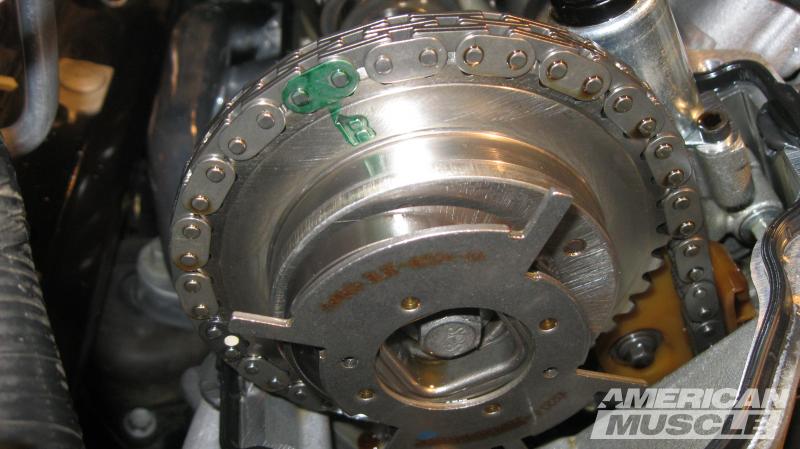
Phaser Limiter Kit
Camshaft Specifications
When looking at a camshaft there are some terms often thrown around, and defining these terms may prove useful when shopping for a camshaft. Although basic understanding of these aspects help to tell you how the camshaft will operate, it’s always a good idea to consult the manufacturer or speed shop to get assistance in determining the best camshaft for your particular application. Keep in mind, when fellow modders talk about bigger cams, they're often referencing how the cam has more lift and duration. The bigger the cam, the more you'll have to worry about piston-to-valve clearance.
- Centerline: Where the lobe hits its peak lift after opening the valve
- Duration: The degrees of rotation the valve is held open
- Lift: How far the lobe opens the valve
- Lobe Separation Angle: The degrees between the centerline of the exhaust and intake lobes. Usually responsible for the "lopey" sound of aggressive cam profiles
- Overlap: The degrees that both the intake and exhaust valves are open
Note: duration can be measured in two ways: from seat to seat, and valve lift. For example, a 300 degree duration can be 300 degrees from valve seat to valve seat, or 300 degrees from 0.020 inches of lift to 0.020 inches of lift. In general, duration measured by valve lift is more accurate than a cam measured from seat to seat.
The standard of .050 inches is used to measure duration on the lobes to simplify things since there are many cam manufacturers. So, duration is measured .050 inches after the intake or exhaust valve opens, and .050 inches before it closes. For example, out of 360 degrees of total cam rotation, the PI intake valve is open for 192 of those degrees at .050 inches lift.
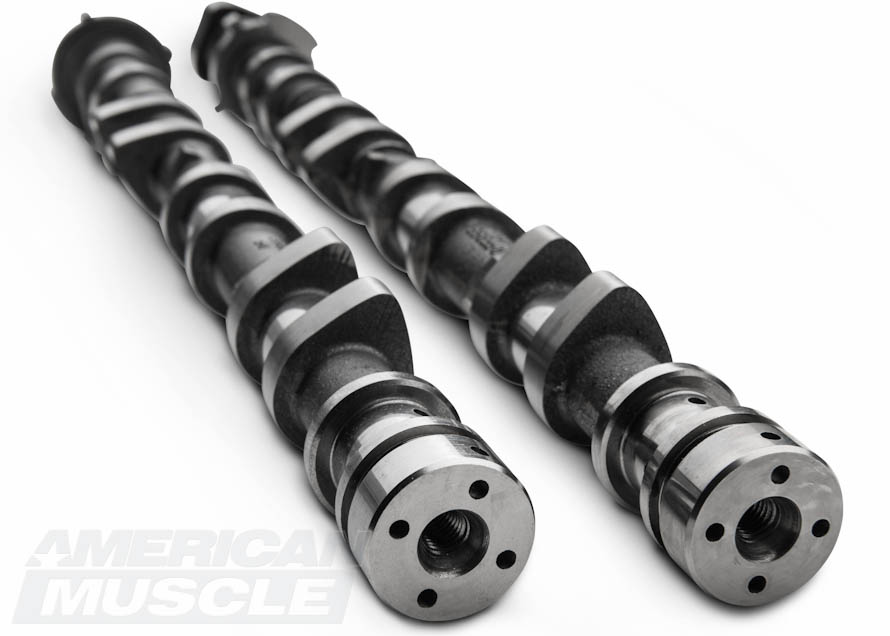
Set of Performance Camshafts
Mustang PI Camshaft Specifications
Mustang Camshaft Specification By Year
| |
Intake Valve Lift |
Intake Duration |
Exhaust Valve Lift |
Exhaust Duration |
| 1985 CFI |
0.416 |
260 |
0.444 |
266 |
| 1985 4-valve & 1986-1988 |
0.444 |
266 |
0.444 |
266 |
| 1988-1993 (Except Cobras) |
276 |
| 1993 Cobra |
0.479 |
270 |
0.479 |
270 |
| 1994-1998 |
0.475 |
272 |
0.460 |
266 |
| 1999-2004 |
0.505 |
201 |
0.535 |
210 |
| 2005-2010 |
0.439 |
196 |
0.436 |
221 |
| 2011-2014 |
0.235 |
263 |
0.216 |
263 |
Forced Induction - Nitrous, Turbochargers, and Superchargers
While a comprehensive breakdown of camshaft variables and theory would take hours, one factor is very important for those going down a forced induction path. That's overlap.
The less overlap you have, the less fuel and boosted air, or nitrous, escapes through the exhaust, maximizing your Mustang's power. At the same time if you're looking for top end, high RPM power some overlap is better. However you will sacrifice some power in the low end.
Several manufacturers offer cams specifically for boosted engines. They also list the individual specs such as duration, lift, and seperation angle. Another key detail is RPM range. Cams potentially have the most influence on where your Mustang makes power, and how much power your Mustang is capable of making.
If you’re exploring the potential of a camshaft, examine your options carefully, and definitely make use of the manufacturers and retailers knowledge. There are plenty of options available, and getting the proper camshaft for your application will reward you with some noticeably extra horsepower.
Supporting mods for Changing Camshafts
A cam swap is the last modification that should be done to the engine. It brings all the other modifications together and had a large impact on the powerband and where it is. As a result, before people change camshaft(s), supporting mods are highly suggested. Such mods can be things like headers, an intake, a higher rear gear (such as 3.73s or 4.10s), etc.
At the same time, some modifications are needed specifically when changing camshafts. These mods are directly related to the valvetrain and include items such as valve springs or retainers. On modular (4.6 and Coyote) mustangs, camshaft sprockets and the phaser bolts must be modified or replaced in certain situations. As with any camshaft(s) swap, a tune is strongly recommended.
In a list, here is what is suggested to add/change:
- Longtube headers
- Cold air intake
- Higher rear gears
- Stronger valve springs: should always be replaced. VSR stands for valve spring required. Otherwise, NSR (non valve spring required)
- Aftermarket valve retainers
- Valve spring retainers
- Timing chains (optional, but highly recommended)
- Crank sprocket (also optional, but also highly recommended)
- A tuner
NOTE: 1999-2004 GTs and Cobras
- Adjustable cam gears (optional)
- Timing chain guides (highly recommended)
- Cam gear bolts (Some 1999-2004 GTs were manufactured with non-removable cam gears and therefore need TrickFlow cam gear spacers
NOTE: 2005-2009 GTs
- Phase limiters
- Phase limiter bolts
- Timing chain guides (highly recommended)
Picking the Right Camshafts
Not all camshafts are created equally. Camshafts are designed to certain specifications for each application. Cam specs vary depending on whether you plan on staying naturally aspirated, adding a supercharger, turbo, or maybe even a shot of nitrous. The benefits of an aftermarket set of camshafts are amplified when used in conjunction with a power adder.
The golden rule of aftermarket cams is as follows: the bigger the cam, the more the cam orients the power band to higher RMPs (the more aggressive the idle becomes). Therefore, the car tends to be sluggish at the lower RPMs. Since the car is sluggish at low RPMs with a larger cam, lower rear end gears (3:55 ) are recommended to help the car get off the line.
The main purpose of a good set of camshafts is to help optimize the engine's powerband. Determine which route you are going to take with your build and then look at the camshafts options available for that setup. Within each setup, there are levels of intensity or “stages” of camshafts.
For example, a stage 1 camshaft is usually very well behaved and will still net you some extra horsepower while a stage 3 camshaft is a bit more radical and will ideally allow you to gain the most power, but there may be other sacrifices that are made in order to achieve that big of a gain in power such as low-end torque or drivability and you will most likely have to purchase a new set of valve springs in order to compensate for the drastic change further adding to the cost.
Why You Often Need New Mustang Valve Springs With Cams
One of the most common question when upgrading camshafts is whether or not you will need to upgrade your valve springs along with it. This all depends on how intense of a camshaft you plan on using in your build.
The bigger the camshaft, the more likely it is that you will have to buy new valve springs. The reasoning is because you will need a stiffer spring to compensate for the added lift of the camshaft in order to make sure the valves are opening and closing properly. If you do not purchase stronger valve springs when it may be necessary than you can potentially cause harm to the motor, especially at high RPM.
NOTE: It is highly recommended to let a performance shop perform the installation of camshafts. This procedure is labor intensive and requires precise measuring to ensure the engine functions properly. This is a good time to have your mechanic to inspect the valvetrain (followers, lash adjusters, valve seals, valves, etc.) for any other issues while the engine is apart.
How do New Camshafts Affect Drivability?
Which Camshafts Should I Buy for My Mustang?
Let's lay out some scenarios you may be in. Your Mustang is bone stock, you drive it daily, but you want a little more power and attitude. You're looking at a stage 1 or 2 cam. These cams will give you a moderate idle, and driveability is basically unaffected. The installation is straightforward since piston-to-valve clearance isn't as large of a concern as the duration and valve lift on these cams are lower than some of the higher stages. In order to avoid PTV issues, you must DEGREE the cams to make sure the cams are opening the valves in sync with the piston stroke.
Second scenario. You have a bunch of bolt-ons. Ported and polished headers, long tube headers, different rear gears, a throttle body, maybe others. A stage 2 cam won't reduce driveability, but if you already have valve relief pistons or the cam timing is advanced with regular dish pistons, you may be able to use a higher stage cam like a stage 3 or 5 assuming you really want to go nuts.
A third scenario. You know you have aftermarket aluminum heads with a 65cc combustion chamber. In order to determine what cam is best for you, you need to know how well the head flows. Any rough casting surface, pinch, or blockage affects the flow of cylinder heads. One of the biggest factors is how far the valve opens. Each cam will tell you how much valve lift it has (Remember: the larger the cam, the more duration, and valve lift). Once you determine valve lift there will be math equations to figure out how much lift equates to how much flow. In this situation, you'll want to contact the mechanic who built your engine. There are a number of variables when trying to decide what cam works best with an aftermarket head.
Tuning For Your New Mustang Camshafts
After you have determined what kind of valvetrain upgrades will work best for your build it is HIGHLY recommended you get a custom tune for the new setup. Camshafts can severely alter the engine's operation and failing to account for these modifications with a tune can potentially damage the engine. An emailed custom tune should be just fine but if you want to take the extra step to make sure the car is perfect I would suggest getting the car dyno tuned.
Fitment includes: 1979, 1980, 1981, 1982, 1983, 1984, 1985, 1986, 1987, 1988, 1989, 1990, 1991, 1992, 1993, 1994, 1995, 1996, 1997, 1998, 1999, 2000, 2001, 2002, 2003, 2004, 2005, 2006, 2007, 2008, 2009, 2010, 2011, 2012, 2013, 2014, 2015, 2016, 2017, 2018, 2019, GT, V6, Cobra, ShelbyGT500, Mach1, Bullitt, Boss, LX, SVO, EcoBoost, ShelbyGT350


